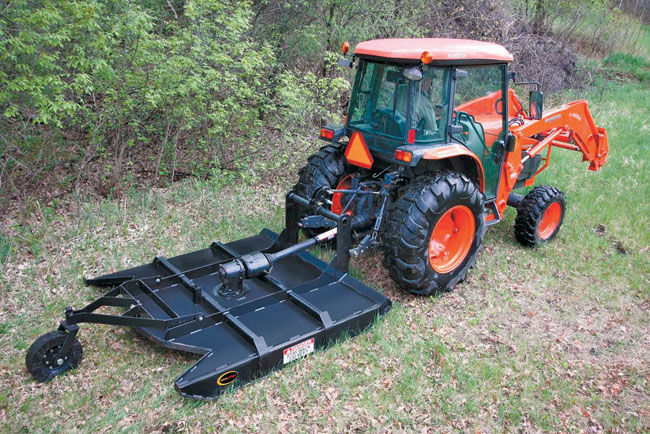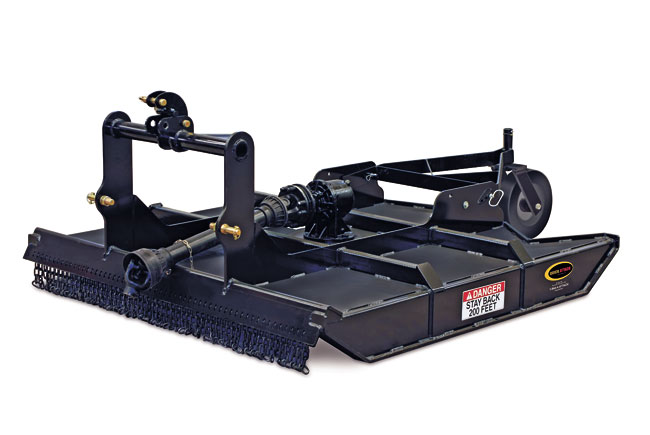A Cut Above
How about we go back about 60 years or so to the farm? Some readers out there might remember it like it was yesterday. Always outside, the fresh smells of the outdoors, a few not so fresh smells from the barn, but still you can’t forget. Some readers out there were yet to be born, but this invention was inevitably going to touch their lives if they grew up on the farm. The three-point brush mower was just that invention.
Prior to the mid-20th century when you needed to clear pasture land for many new purposes, large groups of laborers would grab hay cutting equipment, jump on the tractor and begin the work. After this first step, you would then come back to finish the job with axes and hoes. To clear a cornfield was a different process; it was your tractor, trailer and all those workers using hoes to clear the way. After the three-point brush mower was unveiled, the process would never be the same. Looking very similar to many of today’s models, the mower was large and flat with tires on the back, sharp blades underneath and was powered by the power take-off on the back of your tractor. When the PTO turned, so did the blades.

This is the exact same process as it is today. As they pulled this rotary mower behind the tractor it would level everything in its path. Clear a pasture, done. Clear the cornfield, done. This was just the beginning. Suddenly the mower was being pulled to clear new trails, ditches and every overgrown area you could imagine. It would cut, clear and mulch unwanted brush, thickets, grass and even small trees.
Today’s mower is attached to the tractor using the three-point hitch. Then you hook up the drive shaft on the
mower to the PTO on the tractor. The drive shaft is connected to the gear box placed atop the mower which when engaged turns the blades. The fold back blades turn and cut down everything in their path. If they do hit something too hard to cut, they will bounce back and up as you move past the object, at which time the blades will start to turn forward again. The basic design and concept varies only slightly from that of the mower’s origin.
We could lay out all the specs of the many three-point mowers on the market today. They are mostly 5 to 6 ft wide and 18 in. high and made with seven-gauge steel. Some are made for a Category I hitch and some for a Category II hitch. The fact is, there is a model out there that is perfect for the tractor you own today. What’s the price? For a few thousand dollars you can get one of the best on the market.
Some of the uses of today’s models have changed. You probably would not use a three-point mower to clear your cornfield like years ago. We have many different attachments and machines for some of this mower’s past tasks. The real story is, even though there have been changes due to the technologies available, this mower looks and works almost identically to the way it did when the first one came out in the mid-1900s. It is pretty amazing to see a design in use for more than 60 years continue to work so well with very few changes. It cut clean and smooth then, and it cuts clean and smooth now.
This is a piece of machinery that everyone with a tractor can use. It seems to be a timeless piece of equipment that was here in the 1950s, is here now and will still be here in 2050 and beyond.
Randy Schauer is a product specialist with Quick Attach Attachments Inc., based in Alexandria, Min.
Mow Choices — Finish or Rotary? Pick the Perfect Style of Mower
One of the more specialized attachments, mowers come in a variety of configurations, although they primarily fall into two basic categories: finish mowers and rotary brush cutters. Finish mowers are used to maintain yards and provide a more uniform cut while rotary cutters are for pastures and other areas and do not require a similarly finished cut.
Finish mowers typically have a cutting height range of 3/4 in. to 5 ½ in. and are available in 60- to 70-in. models, but have the option of being front-, mid- or rear-mounted. If mower visibility is important, then a front- or mid-mounted mower would be a good fit; if you prefer a quick-on, quick-off attachment, then a rear-mounted mower is more your speed. Despite the mounting, finish mowers have an optional side discharge feature (rear discharge is standard and allows you to get closer to objects) and chain shields. While shopping around, consider the application and keep in mind that a free-float hitch is necessary on the tractor to allow the mower to follow the ground’s contours. Buyers can expect a price tag in the neighborhood of $1,500 to $3,000.

Rotary cutters are designed to cut grass, weeds and heavy brush at cutting heights ranging from 2 to 14 in. and 3 in. of diameter. Typically, rotary mowers feature a single vertical drive spindle and blade carrier with a “stump jumper” pan and shear bolt or slip clutch to protect the driveline and gearbox from damage. A chain shielding protects the operator and complies with OSHA regulations. Generally made for larger 40- to 70-PTO hp tractors, rotary mowers are available in widths between 60 and 72 in. with 3/8- or 1/2-in. reversible blades. First-time buyers should look for heavy gauge deck construction and a heavy-duty stump jumper. Prices range between $1,200 and $4,000.
Snow Tools
Prepare for the Upcoming Winter Weather with a Tractor Snow Blower
There are front-mounted and three-point-mounted snow blowers for compact tractors — both driven off the PTO system. The PTO driveline from the tractor will connect to a gearbox on the snow blower (whether it’s in the front or back) to drive the auger and the fan in what’s called a two-stage system, which is the most common on this size machine.

The chute can be rotated to place the snow exactly where the operator desires; discharge height can often be adjusted as well. Chute rotation and deflection have several remote-controlled options, which may come electrically or hydraulically driven. Hydraulic chute deflectors list for around $270 and electric chute deflectors list for around $450. Simply flip a switch and a small electric or hydraulic motor moves the chute exactly where it’s needed. Alas, manual rotation will involve getting out of the operator’s seat (ugh!) and turning the crank out in the snow (cold!), which can get old in winter weather.
The range for snow blowers is quite large, depending on how it mounts to the tractor. If the snow blower is front-mounted, there is added cost for the mounting brackets, while a three-point-mounted snow blower will cost less because the additional brackets are not required. A snow blower attachment will range from $2,500 to more than $5,000. Front-mounted snow blowers can cost $2,500 (this includes the PTO shaft and sub-frame for compacts. The snow blower alone is $1,600) to $5,000 (for 72-in. front mount, including sub-frame and PTO — blower; snow blower alone is $3,300). Rear-mounted snow blowers are $2,000 to $3,400.
